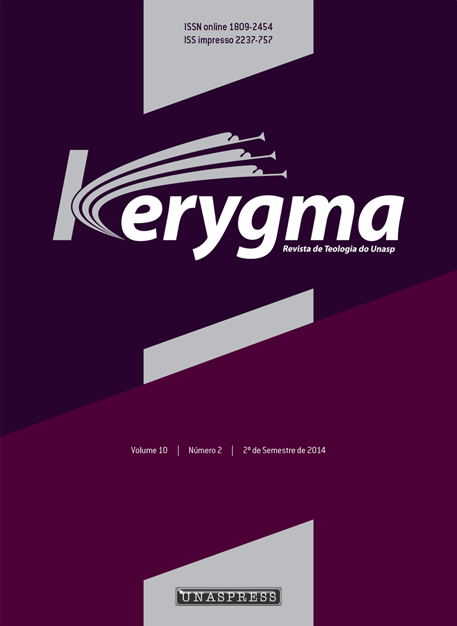Abstract
Grande parte da vida sociorreligiosa que os cristãos exteriorizam e objetivam ao interagir com Deus através da adoração congregacional requer uma análise interpretativa. O sentido religioso que o cristão encontra no ritual de adoração, baseado na consciência religiosa intersubjetiva bíblica da relação dialógica Deus-homem, permite avançar na compreensão da formação e conservação de fé, isto é, na construção e atualização de uma consciência religiosa intersubjetiva. Para isso, o presente artigo usa o método teológico de Bernard Lonergan e os quatro níveis de consciência (empírico, intelectual, racional e responsável), conectado com o modelo pastoral de ver, julgar e agir; e com os três tipos ideais de Jürgen Habermas sobre o perfil ético-professional do cientista social (técnico, prático e dialógico).
Palavras-chave: Consciência Religiosa Intersubjetiva; Níveis de Consciência; Consciência Bíblica.
Abstract: Much of the socio-religious life that Christians externalized and are intended to interact with God through congregational worship requires an interpretative analysis. The religious sense that the Christian finds in ritual worship, based on the biblical religious consciousness of intersubjective dialogic relationship God-man, up through the understanding of the formation and preservation of faith, that is, in building and updating an inter-subjective religious consciousness. In order to do this, the present article uses the theological method of Bernard Lonergan and the four levels of consciousness (empirical, intellectual, rational and responsible), connected with the pastoral model to see, judge and act; and the three ideal types of Jürgen Habermas on the ethical and professional profile of the social scientist (technical, practical and dialogical).
Keywords: Religious inter-subjective consciousness; Awareness levels; Biblical consciousness.
References
AUSTIN MILLÁN, T. Dos momentos en la teoría de Jurgen Habermas, 2000. Disponível em: http://bit.ly/ZWZRSu.
BERGER, P.; LUCKMANN, T. La construcción social de la realidad. Buenos Aires: Amorrortu editores, 1999.
GEERTZ, C. La interpretación de las culturas. Barcelona: Editorial Gedisa, 2005.
HABERMAS, J. Teoría de la Acción Comunicativa. Madrid: Taurus, 1987.
MARZAL, M. Tierra encantada. Tratado de antropología religiosa de América Latina. Lima: Editorial Trota, 2002.
RICOEUR, P. El mal. Un desafío a la filosofía y a la teologia. Buenos Aires: Amorrortu editores, 2007.
RITZER, G. Teoría sociológica contemporânea. Madrid: McGraw-Hill, 1993.
SCANNONE, J. C. Religión y nuevo pensamento: hacia una filosofía de la religión para nuestro tiempo desde América Latina. Barcelona: Anthropos Editorial, 2005.
Authors who publish on Kerygma must agree to the following terms:
- Once accepted for publication, the copyright of articles is automatically transferred to Kerygma.
- All material used in the text that is copyrighted by third parties must be duly referenced.
- Authors must also retain the reproduction rights of images and tables in their material, if necessary.
- The authors guarantee that the submitted text is entirely their authorship and has not been submitted and/or published elsewhere.
- The opinions, ideas and concepts expressed in the texts are the sole responsibility of their authors and do not necessarily represent the opinion of Kerygma;
- The editors reserve the right to make textual adjustments and adapt to the publication's norms.
- Authors retain copyright and grant the journal the right of first publication, with the work simultaneously licensed under Creative Commons Attribution-NonCommercial 4.0 International, which allows sharing of the work with acknowledgment of authorship and initial publication in this journal. This license allows others to remix, adapt, and build upon your work non-commercially, as long as they give proper credit to you and their new works are not used for commercial purposes. However, users are not required to license those derivative works under the same terms.
- The authors agree with the free reproduction of their material by Kerygma, which may adapt, modify, condense, summarize, reduce, compile, expand, alter, mix with other content, include images, graphics, digital objects, infographics and hyperlinks, illustrate, diagram, divide, update, translate and carry out any other transformations, requiring the participation or express authorization of the authors.
- The authors agree that Kerygma can distribute the articles through cable, fiber optics, satellite, airwaves or any other system that allows access to the user at a specific time and place, either by free channels or by systems that import payment. Kerygma may also include work in a physical or virtual database, archiving in printed format, storing on a computer, in a cloud system, microfilming and other current forms of archiving or that may still be developed, with or without profit.
- Authors are permitted to enter into separate, additional agreements for the non-exclusive distribution of the published version of the work in this journal (e.g., publishing it in an institutional repository or as a book chapter), with acknowledgment in the new publication of its initial publication in this journal.
- Kerygma owns the rights to all works published by it. The full reproduction of these texts in other publications, for any other purpose, by any means, requires written authorization from the publisher. The same goes for partial reproductions, such as summary, abstract, portions with more than 500 words of the text, tables, figures, illustrations, etc.
- Authors are granted permission and encouraged to publish and distribute their work online (e.g., in institutional repositories or on their personal websites) at any point before or during the editorial process. This is because it can lead to productive alterations and increase the impact and citation of the published work. (See "The effect of open access and downloads ('hits') on citation impact: a bibliography of studies.")

